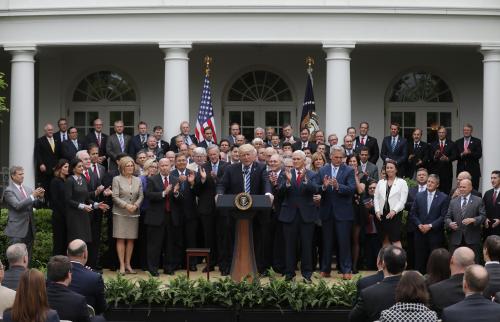Over the past several weeks, as Republicans in the House of Representatives have developed their proposed legislation to make changes to the Affordable Care Act, much of the attention has been on the opposition to the bill from some of the chamber’s conservative members. As the bill moves closer to a scheduled vote in the House on March 23—and, if passed, heads from there to the Senate—a different group of members is also proving important to the bill’s fate: Republicans in the House with concerns about the legislation’s effects on their constituents. Paul Kane of the Washington Post recently called them the “sleeping giants of the Obamacare debate,” while Vox’s Andrew Prokop dubbed them (along with a set of potential allies in the Senate) the “Coverage Caucus.”
To understand why the Coverage Caucus is proving important to the bill’s ultimate prospects, it’s helpful to think about two ways that what happens in Congress can affect members’ electoral chances: by impacting the representative’s individual reputation and by shaping the party’s collective brand. The former can be informed by a wide range of factors, including one’s voting record, the ability to bring federal dollars to one’s district, and the provision of constituency service. The party’s shared reputation, meanwhile, is influenced not only by what it can produce in the way of legislation, but also by the degree to which it can draw clear distinctions from its partisan opponents. In addition, when a party controls both chambers of Congress and the White House, it bears particular responsibility for delivering legislative accomplishments and thus will prioritize getting things done.
In the contemporary Congress, for most members, actions that help their personal reputations and those that build the party brand are one and the same. This is in large part because congressional districts now are generally what Laurel Harbridge Yong describes as “well-sorted,” where a majority of voters support a given party, align themselves ideologically with that party, and support that party’s candidates for federal office. As a result, legislators do not often find themselves making trade-offs between what’s good for the party with what’s good for their constituents.
Just because this kind of cross-pressuring is relatively uncommon, however, doesn’t mean it never occurs and that it doesn’t matter when it does happen. The figure below illustrates which members might feel these kind of forces on the AHCA. It plots an estimate of the number of non-elderly adults who would lose coverage in each district as a result of the AHCA (from David Cutler and Emily Gee and published by the Center for American Progress) against the share of the two-party vote received by each House Republican in 2016 (courtesy of David Wasserman and colleagues at the Cook Political Report). (Note: Florida, North Carolina, and Virginia are excluded from the analysis because of data availability.) Red circles are districts that voted for Trump and blue squares are districts that voted for Clinton.

One group of members who may face trade-offs with their votes are the 17 members from districts with expected coverage losses above the average for Republican districts (roughly 51,000) who either won their election with less than 60 percent of the vote in 2016 and/or saw Clinton win a majority of the presidential votes in their district. A second and perhaps more interesting group are New York’s Republican representatives, denoted as green triangles. Of the 20 Republican districts predicted to experience the most coverage losses in CAP’s analysis, four are in New York; the state’s other five are all also above the average for GOP seats. These acute constituency pressures may help explain why the House leadership added a Medicaid change specifically targeted at upstate New York to the bill; the provision could lead to reduction in voters’ property tax rates. With that language included, these cross-pressured members may be able to claim credit for something that helps their constituents, even if other parts of the bill ultimately make them worse off.
Importantly, if the Coverage Caucus is persuaded to support the bill, it could have negative downstream consequences. One result of the nationalization of House elections documented by Gary Jacobson is that it has become harder for House incumbents to hold their seats when their districts are balanced or lean towards the opposite party. Indeed, members would be well-served to learn a lesson from the Democrats’ experience with the original adoption of the ACA in 2009 and 2010. Research by Brendan Nyhan and colleagues finds that, in 2010, the likely reason that Democrats who voted for the original Affordable Care Act were penalized by voters for doing so was because their constituents perceived them as more liberal as a result of the vote. That suggests that if the skeptics in the Coverage Caucus are pressured into voting for the AHCA, it could make them appear to their constituents as more conservative in 2018 and threaten their ability to hold on to their seats.
As I wrote before Trump’s address to Congress in February, political science research has found that the ability of the president to persuade members of Congress to do things they might otherwise avoid depends, in part, on his approval rating. Trump’s overall approval numbers remain low, so appeals to the president’s popularity may do little to assuage the concerns of legislators like the 23 Republicans who represent districts that voted for Hillary Clinton. (The fact that Trump remains popular among Republican identifiers, meanwhile, may be part of what helps bring some reluctant conservatives on board with the bill.)
In the end, many potential Coverage Caucus members may vote for the AHCA; in addition to the New Yorkers targeted by the state-specific Medicaid provision, several other moderates announced their support after changes to the bill in the form of a manager’s amendment were released. Alternatively, if a sufficient number of the bill’s conservative critics are ultimately persuaded to vote for the bill, the Coverage Caucus’s objections may not matter for the measure’s ultimate prospects. Given the skepticism of some similarly situated Senate colleagues, however, constituency-based concerns from members may continue to play a significant role in the legislation’s ultimate fate.
The Brookings Institution is committed to quality, independence, and impact.
We are supported by a diverse array of funders. In line with our values and policies, each Brookings publication represents the sole views of its author(s).








Commentary
Constituents and the GOP party brand put pressure on health care vote
March 21, 2017